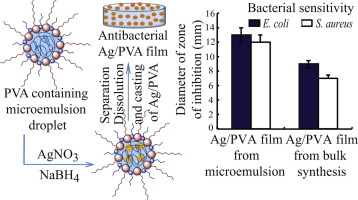Journal of Colloid and Interface Science ( IF 9.4 ) Pub Date : 2017-12-30 , DOI: 10.1016/j.jcis.2017.12.084 Ummul K. Fatema , M. Muhibur Rahman , M. Rakibul Islam , M. Yousuf A. Mollah , Md. Abu Bin Hasan Susan

|
Hypothesis
Water in oil microemulsion (w/o) is a simple preparative route for nanoparticles where water droplets (dispersed in continuous oil medium and stabilized by surfactants and cosurfactants) act as nanoreactors to carry out chemical reactions. If polymeric matrix is incorporated inside the core of the microemulsions, it should prevent the agglomeration of nanoparticles after separation from microemulsions. Thus polymer nanocomposite films prepared from w/o microemulsions are expected to give narrow and homogeneous size distribution of nanoparticles throughout the polymer host.
Experiments
Silver/poly(vinyl alcohol) (Ag/PVA) nanocomposite film was successfully prepared, for the first time, using Triton X-100 (TX-100)/1-butanol/cyclohexane/water microemulsion. Reduction of the metal salt was carried out in the core of w/o microemulsion droplets containing PVA polymeric matrix. After separation from the microemulsion, Ag/PVA nanocomposite film was then prepared by solution casting method. The antibacterial activity of the nanocomposites was tested against Gram-negative, Escherichia coli and Gram-positive, Staphylococcus aureus by agar diffusion method.
Findings
Ag nanoparticles with an average diameter of 105 nm could be synthesized using PVA, whereas in the absence of PVA the nanoparticles agglomerated. The distribution of Ag nanoparticles on PVA surface of the nanocomposite film prepared using microemulsion was uniform, whereas the film prepared through in situ generation of Ag nanoparticles by chemical reduction process on PVA host showed non-uniform, coagulated, bunches of Ag nanoparticles. The film synthesized using microemulsion exhibited enhanced antibacterial efficacy compared to that prepared through in situ synthesis under the same test condition.
中文翻译:

使用油包水型微乳液制备的银/聚乙烯醇纳米复合薄膜,用于抗菌应用
假设
油包水微乳液(w / o)是纳米颗粒的简单制备途径,其中水滴(分散在连续的油介质中,并通过表面活性剂和助表面活性剂稳定)充当纳米反应器来进行化学反应。如果将聚合物基质掺入微乳剂的芯内,则应在与微乳剂分离后防止纳米颗粒的团聚。因此,预期由w / o微乳液制备的聚合物纳米复合材料膜将在整个聚合物主体中提供纳米颗粒的窄而均匀的尺寸分布。
实验
首次成功使用Triton X-100(TX-100)/ 1-丁醇/环己烷/水微乳液成功制备了银/聚乙烯醇(Ag / PVA)纳米复合膜。在不含PVA聚合物基质的微乳液液滴的芯中进行金属盐的还原。从微乳液中分离后,然后通过溶液流延法制备Ag / PVA纳米复合膜。通过琼脂扩散法测试了纳米复合材料对革兰氏阴性大肠杆菌和金黄色葡萄球菌的抗菌活性。
发现
可以使用PVA合成平均直径为105 nm的Ag纳米颗粒,而在不存在PVA的情况下,纳米颗粒会团聚。用微乳液制备的纳米复合膜中,Ag纳米颗粒在PVA表面的分布是均匀的,而在PVA主体上通过化学还原法原位生成Ag纳米颗粒制备的膜则显示出不均匀,凝结的Ag纳米颗粒束。与在相同测试条件下通过原位合成制备的薄膜相比,使用微乳液合成的薄膜显示出增强的抗菌功效。











































 京公网安备 11010802027423号
京公网安备 11010802027423号